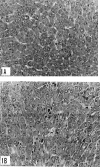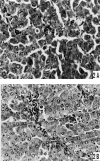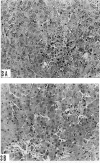Manipulation of nitric oxide in an animal model of acute liver injury. The impact on liver and intestinal function
- PMID: 21503257
- PMCID: PMC3078277
- DOI: 10.4176/070212
Manipulation of nitric oxide in an animal model of acute liver injury. The impact on liver and intestinal function
Abstract
Background: Nitric oxide may have a protective effect on the liver during endotoxemia and chronic inflammation. There is evidence that it maintains liver and intestinal tissue integrity during inflammatory processes. We evaluated the impact of altering nitric oxide release on acute liver injury, the associated gut injury and bacterial translocation, at different time intervals.
Methods: An acute rat liver injury model induced by D-galactosamine was used. Sprague Dawley rats were divided into four main groups: normal control, acute liver injury control, acute liver injury + N-nitro-L-arginine methyl ester (L-NAME), acute liver injury + L-NAME + L-arginine. Each group was divided into three subgroups according to the different time intervals (6, 12, 24 hours) after the induction of the liver injury. Liver enzymes and bilirubin were evaluated, as well as bacterial translocation, cecal and colonic microflora, and histological study of liver, ileum and cecum.
Results: Liver enzymes increased significantly at all time intervals in acute liver injury + L-NAME compared to liver injury control groups. Bacterial translocation increased significantly in liver injury + L-NAME groups; at 6 hours to the liver, at 12 hours to the liver and mesenteric lymph nodes (MLNs), and at 24 hours to arterial and portal blood, liver and MLNS. Inhibition of nitric oxide increased significantly the Enterobacteriaceae count in cecum compared to normal and liver injury control groups. The G-negative anaerobes increased significantly in the colon compared to the liver injury control group.
Conclusion: Inhibition of nitric oxide in an acute liver injury model potentiates the liver injury as evidenced by increased appearance of hepatocellular necrosis and elevated liver enzymes and bilirubin. It increases the Enterobacteriaceae in both cecum and colon and Gnegative anaerobes in the colon. It also increases bacterial translocation to extra-intestinal sites. The increased bacterial translocation could be one of the mechanisms potentiating liver injury and nitric oxide may be pathophysiologically involved. Further studies are required to confirm this hypothesis.
Keywords: Acute liver injury; Arginine; Bacterial translocation; Intestinal microflora; L-NAME; Nitric oxide.
Figures



Similar articles
-
Inhibition of nitric oxide production and the effects of arginine and Lactobacillus administration in an acute liver injury model.Ann Surg. 1998 Dec;228(6):748-55. doi: 10.1097/00000658-199812000-00005. Ann Surg. 1998. PMID: 9860473 Free PMC article.
-
Inhibition of nitric oxide modulates the effect of oral arginine supplementation in acute liver injury.Scand J Gastroenterol. 1997 Aug;32(8):835-40. doi: 10.3109/00365529708996543. Scand J Gastroenterol. 1997. PMID: 9282978
-
Effects of different probiotic strains of Lactobacillus and Bifidobacterium on bacterial translocation and liver injury in an acute liver injury model.Int J Food Microbiol. 2001 Nov 8;70(3):213-20. doi: 10.1016/s0168-1605(01)00550-5. Int J Food Microbiol. 2001. PMID: 11764187
-
Effect of Lactobacillus supplementation with and without arginine on liver damage and bacterial translocation in an acute liver injury model in the rat.Hepatology. 1997 Mar;25(3):642-7. doi: 10.1002/hep.510250325. Hepatology. 1997. PMID: 9049212
-
Bacterial translocation in acute liver injury induced by D-galactosamine.Hepatology. 1996 Jan;23(1):97-103. doi: 10.1002/hep.510230114. Hepatology. 1996. PMID: 8550055
Cited by
-
Role of endotoxemia in causing renal dysfunction in cirrhosis.J Investig Med. 2020 Jan;68(1):26-29. doi: 10.1136/jim-2019-001056. Epub 2019 Jul 19. J Investig Med. 2020. PMID: 31324695 Free PMC article. Review.
-
Pharmacokinetics and tissue distribution of bleomycin-induced idiopathic pulmonary fibrosis rats treated with cryptotanshinone.Front Pharmacol. 2023 Mar 9;14:1127219. doi: 10.3389/fphar.2023.1127219. eCollection 2023. Front Pharmacol. 2023. PMID: 36969870 Free PMC article.
-
Intake of Blueberry Fermented by Lactobacillus plantarum Affects the Gut Microbiota of L-NAME Treated Rats.Evid Based Complement Alternat Med. 2013;2013:809128. doi: 10.1155/2013/809128. Epub 2013 Apr 9. Evid Based Complement Alternat Med. 2013. PMID: 23690854 Free PMC article.
References
-
- Moncada S, Higgs EA. Endogenous nitric oxide: physiology, pathology and clinical relevance. Eur J Clin Invest. 1991;21:361–374. - PubMed
-
- Stuehr DJ, Marletta MA. Induction of nitrite/nitrate synthesis in murine macrophages by BCG infection, lymphokines or interferon. J Immunol. 1987;139:518–525. - PubMed
-
- Keller R, Keist R, Klauser S, Schweiger A. The macrophage response to bacteria: Flow of L-arginine through the nitric oxide and urea pathways and induction of tumoricidal activity. Biochem Biophys Res Commun. 1991;177:821–827. - PubMed
-
- Billiar TR, Curran RD, Stuehr DJ, Stadler J, Simmons RL, Murray SA. Inducible cytosolic enzyme activity for the production of nitrogen oxides from L-arginine in hepatocytes. Biochem Biophys Res Commun. 1990;168:1034–1040. - PubMed
LinkOut - more resources
Full Text Sources
